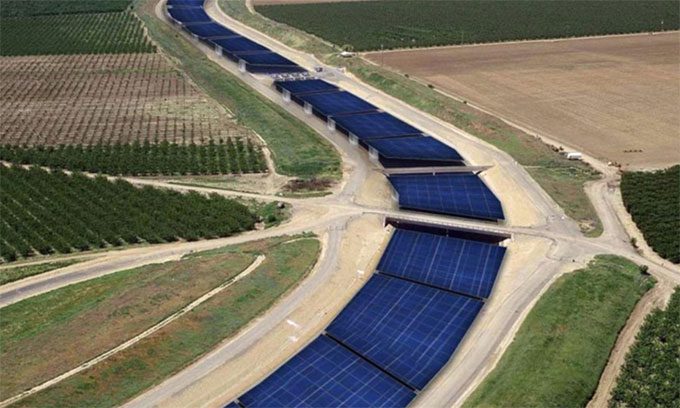“Solar canals” could enhance electricity production efficiency and save billions of gallons of water in California.
Climate change is causing weather to become hotter and drier. In drought-prone areas like California in the United States, water is a major concern. Frequent droughts over the past 10 to 30 years have depleted many of the state’s water sources. Since April of this year, all areas of California have experienced drought conditions, prompting authorities to implement water use restrictions.
In a new study published in the journal Nature, experts from the University of California, Merced, and the University of California, Santa Cruz, have proposed an ambitious water conservation solution by installing solar panels covering 6,437 km of canals in California – one of the largest water supply systems in the world.

Simulation of a canal after installing solar panels in California. (Photo: Solar Aquagrid LLC).
This idea will help both the electrical and water systems operate more efficiently. The shade from the solar panels will reduce evaporation from the canals, particularly during the hot summer months in California. The researchers’ calculations suggest that this could save the entire state up to 63 billion gallons of water each year. Moreover, the solar panels blocking sunlight will inhibit the growth of aquatic weeds, leading to lower maintenance costs for the canals.
Conversely, because the water under the canals is shielded from sunlight, it will heat up more slowly than the surrounding land, helping to cool the solar panels. The study indicates that this could boost electricity production efficiency by up to 3%.
These panels could also generate local electricity across many areas of California, thereby reducing transmission losses and costs for consumers. Combining solar energy with storage batteries could help establish microgrid systems in rural and remote areas, making the electrical system more efficient and minimizing risks of power outages due to extreme weather, human error, and wildfires.
Dr. Brandi McKuin, the lead author of the study, notes that the cost of installing solar panels on the canals would be higher than that of ground-mounted farms. However, given the substantial benefits it offers, this project is well worth the investment.
“Our estimates suggest that solar canals could provide about 13 gigawatts of renewable energy capacity, accounting for approximately half of the new sources California needs to meet its clean energy goals: 60% from non-carbon sources by 2030 and 100% by 2045,” McKuin emphasized.


















































